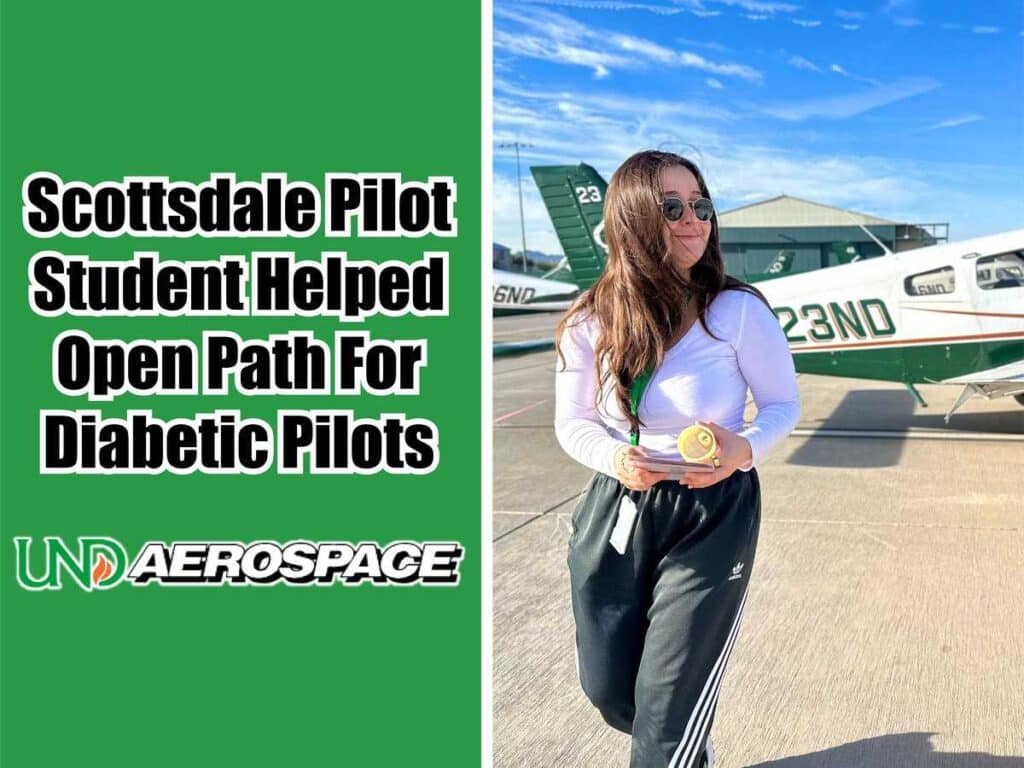Pursuing a career as a commercial pilot is a dream shared by many. However, for individuals with certain medical conditions, such as diabetes, this dream seemed unattainable in the past.
Traditionally, persons with diabetes who rely on insulin were barred from working as commercial aviators due to concerns about keeping their blood sugar levels in check during flight. However, with advancements in medical technology and a better understanding of diabetes management, the aviation industry has recently started re-evaluating these restrictions.
The success story of Natalie Schatton, a diabetic student pursuing commercial pilot training at the UND Aerospace Phoenix Flight Training Center, is helping inspire and encourage more insulin-dependent persons with diabetes who dream of becoming pilots to pursue their dreams.
Natalie’s Story: Overcoming Diabetes to Become a Commercial Pilot
Natalie Schatton’s passion for aviation began at a young age, influenced by her father, who flies for American Airlines, and her mom, who worked as a flight attendant for United Airlines. Her dream was to one day fly for a major commercial airline.
However, her dreams of becoming a commercial pilot seemed out of reach due to a diabetes diagnosis at age 10. Until 2020, insulin-dependent diabetic pilots were restricted from obtaining a first class airman medical certificate, barring them from working for commercial airlines.
However, with growing evidence that well-managed diabetes should not be a barrier to piloting commercial flights, the Federal Aviation Administration (FAA) relaxed its stance. They began issuing first class medical certificates to qualifying individuals who presented the required data from their continuous glucose monitors.
This shift in perspective was partly due to the emergence of advanced continuous glucose monitors. These small wearable devices automatically detect blood sugar levels every few minutes and transmit the readings to a mobile phone, allowing pilots with diabetes to manage their condition in real time.
This technological advancement in the medical industry ensures that pilots with diabetes can maintain their blood sugar levels within the safe range, minimizing the risk of hypoglycemic or hyperglycemic episodes during flight.
These devices have also helped pilots with diabetes like Pietro Marsala, another Scottsdale aviator who has been leading the charge in pushing the FAA to reconsider its stance on individuals with diabetes, compile vital data showing that well-managed diabetes poses little to no risk to flight safety.
Pietro Marsala’s Advocacy for Diabetic Pilots
Pietro Marsala, a key figure in the movement advocating for special allowances for pilots with diabetes who meet specific medical requirements, played a pivotal role in opening doors for individuals like Natalie Schatton.
Through his tireless efforts, Marsala—then working as a certified flight instructor (one of few job descriptions that pilots with diabetes were allowed to take on)—presented data from his blood sugar monitor and continually advocated for diabetic pilots who meet stipulated medical requirements to obtain a first-class medical certificate.
Marsala is just one of many individuals and organizations, including the American Diabetes Association, that lobbied for this groundbreaking move to allow insulin-dependent pilots to work as commercial airline pilots, opening the door for many aspiring pilots like Natalie to realize their dreams.
A BIG Win For Natalie and Other Individuals With Diabetes
Thanks to the efforts of individuals like Marsala, persons with diabetes now have the opportunity to prove their abilities and contribute to the fast-growing aviation industry. This positive shift is not only a big win for aspiring pilots who have diabetes but also promotes inclusivity and diversity within the profession.
Natalie’s journey through the rigorous process of obtaining her medical certificate was a monumental personal achievement. But most importantly, it has helped raise awareness and set a precedent for other diabetic individuals aspiring to become commercial airline pilots.
With the main obstacle out of the way, Natalie’s renewed passion for becoming a commercial pilot led her to UND Aerospace Phoenix Flight Training Center, one of the best flight schools in Arizona, where she’s pursuing a commercial pilot license under our accelerated pilot training program.
At UND Aerospace Phoenix Flight Training Center, we are proud to offer some of the country’s most comprehensive flight training programs. Our commitment to student success is evident in our state-of-the-art facilities, experienced flight instructors, and a rigorous curriculum designed to meet the demands of today’s aviation industry.
Discover The UND Aerospace Phoenix Flight Training Center
The determination and inspiring stories of Pietro, Natalie, and others are helping drive inclusivity and diversity in the aviation industry, enriching the field with talented individuals who might have been sidelined unfairly in the past.
At UND Aerospace Foundation, we are committed to helping all aspiring individuals realize their dream of becoming professional aviators. Our flight training programs are designed to support students with diverse needs, including those with medical conditions like diabetes, ensuring they have the necessary resources to succeed.
We’re delighted that Natalie, one of our own, is at the forefront of spreading awareness and encouraging more individuals with diabetes to pursue their dream of becoming professional pilots through her inspiring story.
Are you looking to become a commercial pilot in Arizona? Enroll at UND Aerospace and discover why we are one of the best flight schools in USA.

